by Calculated Risk on 4/08/2024 08:12:00 AM
Monday, April 08, 2024
Housing April 8th Weekly Update: Inventory down 0.9% Week-over-week due to Easter Holiday, Up 24.6% Year-over-year
 Click on graph for larger image.
Click on graph for larger image.This inventory graph is courtesy of Altos Research.
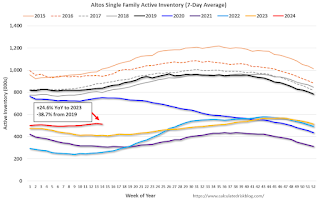
Sunday, April 07, 2024
Sunday Night Futures
by Calculated Risk on 4/07/2024 06:11:00 PM
Weekend:
• Schedule for Week of April 7, 2024
Monday:
• No major economic releases scheduled.
From CNBC: Pre-Market Data and Bloomberg futures S&P 500 are up 14 and DOW futures are up 99 (fair value).
Oil prices were up over the last week with WTI futures at $86.91 per barrel and Brent at $91.17 per barrel. A year ago, WTI was at $80, and Brent was at $87 - so WTI oil prices are up about 8% year-over-year.
Here is a graph from Gasbuddy.com for nationwide gasoline prices. Nationally prices are at $3.58 per gallon. A year ago, prices were at $3.58 per gallon, so gasoline prices are unchanged year-over-year.
AAR: Rail Carloads Down YoY in March, Intermodal Up
by Calculated Risk on 4/07/2024 08:21:00 AM
From the Association of American Railroads (AAR) Rail Time Indicators. Graphs and excerpts reprinted with permission.
Total originated carloads on U.S. railroads fell 3.5% (31,101 carloads) in March 2024 from March 2023, their third straight monthly decline. Total carloads averaged 216,716 per week in March 2024, the fewest for any March in our records that begin in January 1988. In the first quarter of 2024, total carloads were down 4.2%, or 122,088 carloads, from the same period in 2023.
The problem is coal. ...
U.S. railroads also originated 1.02 million intermodal containers and trailers in March, up 11.7% (106,903 units) over March 2023 and their seventh consecutive year-over-year gain.
emphasis added
 Click on graph for larger image.
Click on graph for larger image.This graph from the Rail Time Indicators report shows the six-week average of U.S. Carloads in 2022, 2023 and 2024:
In March, total originated U.S. carloads fell 3.5% (31,101 carloads) from March 2023. They averaged 216,716 per week in March 2024, the fewest for any March in our records that begin in January 1988. Total carloads were down 4.2%, or 122,088 carloads, for the year to date.
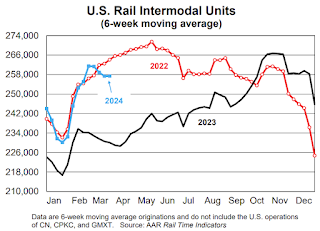 The second graph shows the six-week average (not monthly) of U.S. intermodal in 2022, 2023 and 2024: (using intermodal or shipping containers):
The second graph shows the six-week average (not monthly) of U.S. intermodal in 2022, 2023 and 2024: (using intermodal or shipping containers):U.S. railroads originated 1.02 million intermodal containers and trailers in March, up 11.7% (106,903 units) over March 2023. It’s their seventh straight year-over-year gain. ... U.S. intermodal volume in Q1 2024 was 3.27 million units, virtually the same as the average for the first quarters from 2014 to 2023 (3.28 million).
Saturday, April 06, 2024
Real Estate Newsletter Articles this Week: Office Vacancy Rate at Record High
by Calculated Risk on 4/06/2024 02:11:00 PM
At the Calculated Risk Real Estate Newsletter this week:
• Moody's: Apartment Vacancy Rate Unchanged in Q1; Office Vacancy Rate at Record High
• Freddie Mac House Price Index Increased in February; Up 5.9% Year-over-year
• ICE Mortgage Monitor: The Impact of "Golden-Handcuffs" on Mortgage Payments
• Asking Rents Mostly Unchanged Year-over-year
• Immigration and Household Formation
This is usually published 4 to 6 times a week and provides more in-depth analysis of the housing market.
Schedule for Week of April 7, 2024
by Calculated Risk on 4/06/2024 08:11:00 AM
The key economic report this week is March CPI.
No major economic releases scheduled.
6:00 AM ET: NFIB Small Business Optimism Index for March.
7:00 AM ET: The Mortgage Bankers Association (MBA) will release the results for the mortgage purchase applications index.
8:30 AM: The Consumer Price Index for March from the BLS. The consensus is for 0.4% increase in CPI (up 3.5% YoY) and a 0.3% increase in core CPI (up 3.7% YoY).
2:00 PM: FOMC Minutes, Meeting of March 19-20
8:30 AM: The initial weekly unemployment claims report will be released. The consensus is for 225 thousand initial claims, up from 221 thousand last week.
8:30 AM: The Producer Price Index for March from the BLS. The consensus is for a 0.2% increase in PPI, and a 0.3% increase in core PPI.
10:00 AM: University of Michigan's Consumer sentiment index (Preliminary for April).
Friday, April 05, 2024
April 5th COVID Update: Weekly Deaths Decreased
by Calculated Risk on 4/05/2024 07:21:00 PM
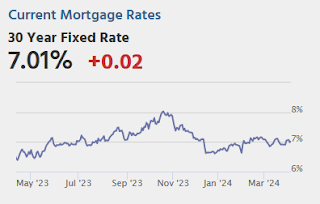
| COVID Metrics | ||||
|---|---|---|---|---|
| Now | Week Ago | Goal | ||
| Hospitalized2 | 7,401 | 8,705 | ≤3,0001 | |
| Deaths per Week2 | 1,002 | 1,198 | ≤3501 | |
| 1my goals to stop weekly posts, 2Weekly for Currently Hospitalized, and Deaths 🚩 Increasing number weekly for Hospitalized and Deaths ✅ Goal met. | ||||
 Click on graph for larger image.
Click on graph for larger image.This graph shows the weekly (columns) number of deaths reported.
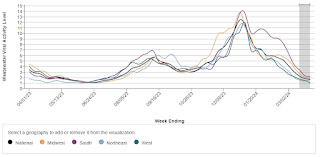 This appears to be a leading indicator for COVID hospitalizations and deaths.
This appears to be a leading indicator for COVID hospitalizations and deaths.Q1 GDP Tracking: 2% to 2.5%
by Calculated Risk on 4/05/2024 03:10:00 PM
From BofA:
Since our update last week, 1Q GDP tracking is down two-tenths to 2.0% q/q saar. Also, 4Q GDP came in at 3.4% q/q saar in the third and final estimate, close to our 3.5% forecast. [Apr 5th estimate]From Goldman:
emphasis added
The details of the trade balance report were somewhat firmer than our previous expectations, and we boosted our Q1 GDP tracking estimate by 0.2pp to +2.5%. [Apr 4th estimate]And from the Altanta Fed: GDPNow
The GDPNow model estimate for real GDP growth (seasonally adjusted annual rate) in the first quarter of 2024 is 2.5 percent on April 4, down from 2.8 percent on April 1. [April 4th estimate]
Wholesale Used Car Prices Declined in March; Down 14.7% Year-over-year
by Calculated Risk on 4/05/2024 11:59:00 AM
From Manheim Consulting today: Wholesale Used-Vehicle Prices Declined in March
Wholesale used-vehicle prices (on a mix, mileage, and seasonally adjusted basis) were down in March compared to February. The Manheim Used Vehicle Value Index (MUVVI) fell to 203.1, a decline of 14.7% from a year ago. The decline in the index was driven by the seasonal adjustment, resulting in a 0.4% month-over-month decrease. The non-adjusted price in March increased by 3.1% compared to February, moving the unadjusted average price down 11.4% year over year.
emphasis added
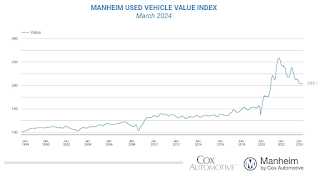 Click on graph for larger image.
Click on graph for larger image.This index from Manheim Consulting is based on all completed sales transactions at Manheim’s U.S. auctions.
Comments on March Employment Report
by Calculated Risk on 4/05/2024 09:10:00 AM
The headline jobs number in the March employment report was above expectations; and January and February payrolls were revised up by 22,000 combined. The participation rate and the employment population ratio both increased, and the unemployment rate decreased to 3.8%.
Prime (25 to 54 Years Old) Participation
 Since the overall participation rate is impacted by both cyclical (recession) and demographic (aging population, younger people staying in school) reasons, here is the employment-population ratio for the key working age group: 25 to 54 years old.
Since the overall participation rate is impacted by both cyclical (recession) and demographic (aging population, younger people staying in school) reasons, here is the employment-population ratio for the key working age group: 25 to 54 years old.The 25 to 54 years old participation rate decreased in March to 83.4% from 83.5% in February, and the 25 to 54 employment population ratio was unchanged at to 80.7% from 80.7% the previous month.
Average Hourly Wages
 The graph shows the nominal year-over-year change in "Average Hourly Earnings" for all private employees from the Current Employment Statistics (CES).
The graph shows the nominal year-over-year change in "Average Hourly Earnings" for all private employees from the Current Employment Statistics (CES). Wage growth has trended down after peaking at 5.9% YoY in March 2022 and was at 4.1% YoY in March.
Part Time for Economic Reasons
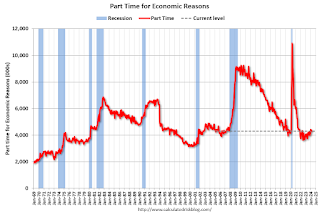 From the BLS report:
From the BLS report:"The number of people employed part time for economic reasons, at 4.3 million, changed little in March. These individuals, who would have preferred full-time employment, were working part time because their hours had been reduced or they were unable to find full-time jobs."The number of persons working part time for economic reasons decreased in March to 4.31 million from 4.36 million in February. This is at pre-pandemic levels.
These workers are included in the alternate measure of labor underutilization (U-6) that was unchanged at 7.3% from 7.3% in the previous month. This is down from the record high in April 2020 of 23.0% and up from the lowest level on record (seasonally adjusted) in December 2022 (6.5%). (This series started in 1994). This measure is above the 7.0% level in February 2020 (pre-pandemic).
Unemployed over 26 Weeks
 This graph shows the number of workers unemployed for 27 weeks or more.
This graph shows the number of workers unemployed for 27 weeks or more. According to the BLS, there are 1.246 million workers who have been unemployed for more than 26 weeks and still want a job, up from 1.203 million the previous month.
This is close to pre-pandemic levels.
Job Streak
| Headline Jobs, Top 10 Streaks | ||
|---|---|---|
| Year Ended | Streak, Months | |
| 1 | 2019 | 100 |
| 2 | 1990 | 48 |
| 3 | 2007 | 46 |
| 4 | 1979 | 45 |
| 5 | 20241 | 39 |
| 6 tie | 1943 | 33 |
| 6 tie | 1986 | 33 |
| 6 tie | 2000 | 33 |
| 9 | 1967 | 29 |
| 10 | 1995 | 25 |
| 1Currrent Streak | ||
Summary:
The headline jobs number in the March employment report was above expectations; and January and February payrolls were revised up by 22,000 combined. The participation rate and the employment population ratio both increased, and the unemployment rate decreased to 3.8%. Another strong report.
March Employment Report: 303 thousand Jobs, 3.8% Unemployment Rate
by Calculated Risk on 4/05/2024 08:30:00 AM
From the BLS:
Total nonfarm payroll employment rose by 303,000 in March, and the unemployment rate changed little at 3.8 percent, the U.S. Bureau of Labor Statistics reported today. Job gains occurred in health care, government, and construction.
...
The change in total nonfarm payroll employment for January was revised up by 27,000, from +229,000 to +256,000, and the change for February was revised down by 5,000, from +275,000 to +270,000. With these revisions, employment in January and February combined is 22,000 higher than previously reported.
emphasis added
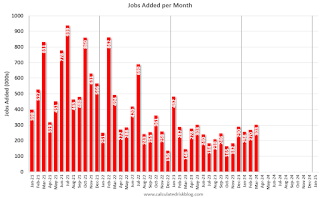 Click on graph for larger image.
Click on graph for larger image.The first graph shows the jobs added per month since January 2021.
Payrolls for January and February were revised up 22 thousand, combined.
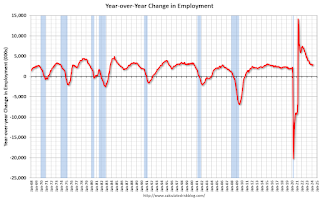 The second graph shows the year-over-year change in total non-farm employment since 1968.
The second graph shows the year-over-year change in total non-farm employment since 1968.In March, the year-over-year change was 2.93 million jobs. Employment was up solidly year-over-year.
The third graph shows the employment population ratio and the participation rate.
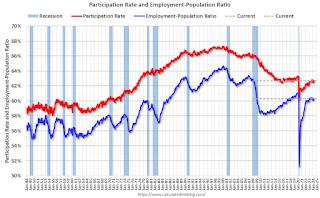 The Labor Force Participation Rate was increased to 62.7% in March, from 62.5% in February. This is the percentage of the working age population in the labor force.
The Labor Force Participation Rate was increased to 62.7% in March, from 62.5% in February. This is the percentage of the working age population in the labor force. The Employment-Population ratio increased to 60.3% from 60.1% (blue line).
I'll post the 25 to 54 age group employment-population ratio graph later.
 The fourth graph shows the unemployment rate.
The fourth graph shows the unemployment rate. The unemployment rate decreased to 3.8% in March from 3.9% in February.
This was well above consensus expectations; and January and February payrolls were revised up by 22,000 combined.


